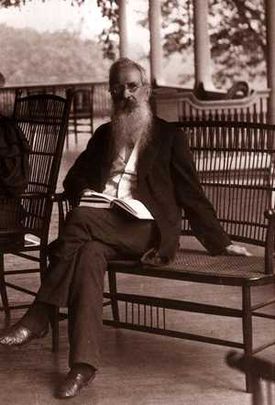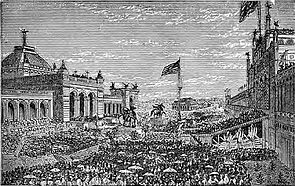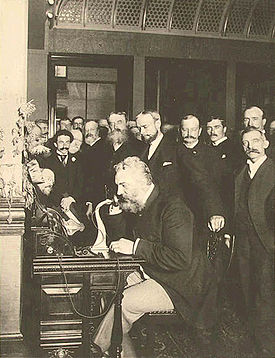- Bell Telephone Company
-
The Bell Telephone Company, a common law joint stock company, was organized in Boston, Massachusetts on July 9, 1877 by Alexander Graham Bell's father-in-law Gardiner Greene Hubbard, who also helped organize a sister company — the New England Telephone and Telegraph Company. The Bell Telephone Company was started on the basis of holding "potentially valuable patents", principally Bell's master telephone patent #174465.[1]
The two companies merged on February 17, 1879 to form two new entities, the National Bell Telephone Company of Boston, and the International Bell Telephone Company, soon-after established by Hubbard and which was headquartered in Brussels, Belgium.[2][3][4] Theodore Vail then took over its operations at that point, becoming a central figure in its rapid growth and commercial success.
The National Bell Telephone Company subsequently merged with others on March 20, 1880 to form the American Bell Telephone Company, also of Boston, Massachusetts.[5]
Upon its inception, the Bell Telephone Company was organized with Hubbard as "trustee", although he was additionally its de facto president since he also controlled his daughter's shares by power of attorney, and with Thomas Sanders, its principal financial backer, as treasurer.[6] The American Bell Telephone Company would later evolve into the American Telephone & Telegraph Company (AT&T), at times the world's largest telephone company.
Contents
Predecessor to the Bell Company
The Bell Patent Association (a name later assigned by historians), was technically not a corporate entity but a trusteeship and a partnership, and was first established verbally in 1874 to be the holders of the patents produced by Bell and his assistant Thomas Watson.
Approximate one third interests were at first held by Gardiner Greene Hubbard, a lawyer and Bell's future father-in-law; Thomas Sanders, the well-to-do leather merchant father of one of Bell's deaf students (and who was the very first to enter into an agreement with Bell); and finally by Alexander Graham Bell himself. Hubbard would subsequently register some of his shares with two other family members. An approximate 10% interest of the patent association was later assigned by its principles to Bell's technical assistant Thomas Watson, in lieu of salary and for his earlier financial support to Bell while they worked together creating their first functional telephones.
The verbal Patent Association agreement was first formalized in a memorandum of agreement on February 27, 1875.[7] The Patent Association's assets would later became the foundational assets of the Bell Telephone Company.[8][9]
At the time of the organization of the Bell Telephone Company (also known as the Bell Company) as a joint stock company in 1877 by Hubbard, who became its trustee and de facto president, 5,000 shares in total were issued to:[10]
- Gardiner Greene Hubbard (trustee and president): 1,397 shares, along with
- Gertrude McC. Hubbard, likely Gertrude Mercer McCurdy Hubbard (wife of Gardiner Hubbard): 100 shares
- Charles E. Hubbard (brother of Gardiner Hubbard): 10 shares
- Alexander Graham Bell (inventor and formally the company's 'Chief Electrician'): 1,497 shares
- Thomas Sanders (financier and treasurer): 1,497 shares
- Thomas Watson (head of operations): 499 shares
Two days after the company's formation, on July 11, 1877, Bell married Hubbard's daughter Mabel Gardiner Hubbard, and made a wedding gift of 1,487 shares of his allotment to his new wife, keeping only 10 shares for himself. Bell and his wife left not long after for a tour of Europe that lasted over a year, during which time Mabel left her shares with her father under a power of attorney.
Alexander Graham Bell's ten shares of Bell Telephone Company stock were later converted into a single share of the American Bell Telephone Company, and still later into two shares of the American Telephone and Telegraph Company. AT&T President Frederick Fish would subsequently return Bell's single American Bell Telephone Company share to him as a memento after it had been converted and canceled.[11][12]
Early promotional success
Alexander Graham Bell's fiancée Mabel Hubbard was the indirect source of the Bell Telephone Company's early commercial success after his creation of the telephone. The U.S. Centennial Exposition in Philadelphia in 1876 made Bell's newly invented telephone a featured headline worldwide. Exhibition judges Brazilian Emperor Dom Pedro II and the eminent British physicist William Thomson (Lord Kelvin) recommended his device to the Committee of Electrical Awards, which voted Bell the Gold Medal for Electrical Equipment, helping to propel him to international fame. Bell also won a second Gold Medal for his additional display at the exposition, Visible Speech —developed earlier by his equally famous father Alexander Melville Bell.
Pivotally, late in the evening moments after the main group of tired judges and newspaper reporters had quickly looked over and derided Bell's telephone display, Emperor Dom Pedro, who was straggling, entered the fair's Education Building where Bell's two displays were located. As the main group started moving on to the next exhibit to be reviewed, Dom Pedro came upon the displays and called out to Bell in his booming voice: "What are you doing here?" The emperor had previously met Bell in Boston much earlier while visiting schools for the deaf in the United States.[13][14][15][16][17]
Startled by the emperor's enthusiastic response to Bell's telephone demonstration—during which the emperor exclaimed "My God! It talks!", the crowd of judges and press members became energized and vied to take turns communicating with Bell over his invention.[13][14][15][16][17]
Ironically, Bell, who was then a full-time teacher, hadn't even planned on exhibiting at the fair due to his heavy teaching schedule and preparation for his student's examinations. He went to Philadelphia only at the stern insistence of Mabel Hubbard, his then-fiancée and future wife and who was an expert multilingual lip reader, deaf since age five.[18]
Mabel had understood Bell's reluctance to go to the exhibition and display his works, so she secretly bought his train ticket to Philadelphia, packed his bag, and then took the unknowing Bell to Boston's train station where she told her shocked fiancé that he was going on a trip. When Bell started arguing, Mabel turned her sight away from him and became literally deaf to his protests.[18][19][20]
Acquisition by AT&T
Main articles: American Telephone & Telegraph and Bell SystemBy 1881 American Bell had acquired a controlling interest in the Western Electric Company from Western Union. Only three years earlier, Western Union had turned down Gardiner Hubbard's offer to sell it all rights to the telephone for US$100,000 (approximately $2.27 million in current dollars[21]). In only a few years Western Union's president would acknowledge that it was a serious business error, one that almost led to his company later almost being swallowed up by the newly emerging telecommunications giant that Bell Telephone would shortly evolve into. Western Union was saved from demise only by the U.S. Government's anti-monopoly interventions.[22]
A year earlier in 1880 the management of American Bell had created what would become AT&T Long Lines. The project was the first of its kind to create a nationwide long-distance network with a commercially viable cost-structure. The project was formally incorporated in New York State as a separate company named American Telephone and Telegraph Company on March 3, 1885. Starting from New York, its long-distance telephone network reached Chicago, Illinois, in 1892,[22] with its multitudes of local exchanges continuing to stretch further and further yearly, eventually creating a continent-wide telephone system.
On December 30, 1899, the assets of American Bell were transferred into its subsidiary American Telephone and Telegraph Company (formerly AT&T Long Lines); this was because Massachusetts corporate laws were very restrictive, and limited capitalization to ten million dollars, forestalling American Bell's further growth. With this assets transfer on the second to last day of the 19th Century, AT&T became the parent of both American Bell and the Bell System.[23]
John Elbridge Hudson joined Bell Telephone as counsel in 1880 and served as president from 1889 to 1900. AT&T would later undergo mergers with SBC Communications and BellSouth to become the New AT&T.
See also
- American Telephone & Telegraph
- Bell, Alexander Graham
- The Bell Telephone Company of Canada Ltd., founded in 1880 after its predecessor was sold by Graham Bell's father, Melville Bell, to The National Bell Telephone Company.
- Bell, Mabel Hubbard, wife of Alexander Graham Bell.
- Bell System, a name and trademark formerly used by AT&T.
- Hubbard, Gardiner Greene
- International Bell Telephone Company, the Bell Telephone Company's European division.
- Regional Bell Operating Companies, which were divested from the Bell System in 1984.
- The Telephone Cases, the numerous court cases contesting the validity of the Bell patents.
- Watson, Thomas Augustus, a machinist-fitter and Bell's assistant in creating his earliest telephones.
- Western Electric, co-founded by Bell's early rival Elisha Gray, acquired by the Bell Company's rival Western Union, and finally acquired by the Bell Telephone Company, it became the Bell Company's key manufacturing arm, enabling its rapid expansion across the continent.
References
- Notes
- ^ Pizer 2009, pp.123-124
- ^ Huurdeman, Anton A. The Worldwide History Of Telecommunications, Wiley-IEEE, 2003, ISBN 0471205052, ISBN 9780471205050, pg.179
- ^ Stephen B. Adams, Orville R. Butler. Manufacturing The Future: A History Of Western Electric, Cambridge University Press, 1999, pg.49, ISBN 0521651182, ISBN 9780521651189.
- ^ Pizer 2009, pgs.119, 125
- ^ Pizer 2009, pg.125
- ^ Pizer 2009, pg.127
- ^ Pizer 2009, pg.122
- ^ Bruce 1990, pg.291
- ^ Pizer 2009, pp.120-124
- ^ Pizer 2009, pg.124
- ^ Letter from Fish to Bell, AT&T, April 7, 1905
- ^ Letter from Fish to Bell, AT&T, April 18, 1905
- ^ a b Coon, Horace. American Tel & Tel: the story of a great monopoly, Ayer Publishing, 1971, p.24, ISBN 0836956915, ISBN 9780836956917. Quote: ""On a hot Sunday afternoon, June 25th, Sir William Thompson (later Lord Kelvin) and many other distinguished guests inspected the exhibits. Few paid much attention to Bell, tinkering with his crude instruments. At last the party approached his booth. Among them was Dom Pedro de Alcantara, the Emperor of Brazil. He had met Bell a few weeks previously in Boston and spoke to him as an old friend."
- ^ a b Sammartino McPherson, Stephanie & Butler, Tad. Alexander Graham Bell, Lerner Publications, 2007, p.28, ISBN 0822576066, ISBN 9780822576068. Quote: "Dom Pedro had met Alec at a school for the deaf in Boston. When the emperor greeted Alec, the judges took note. The wanted to see what the emperor's friend had invented."
- ^ a b Cardoso, Fernando Henrique. The Accidental President of Brazil: A Memoir, PublicAffairs, 2007, p.11, ISBN 158648429X, ISBN 9781586484293. Quote: "The centerpiece of the emperor's trip was the Centennial Exposition in Philadelphia. There, Dom Pedro II sought out a young, relatively obscure teacher at the School of the Deaf named Alexander Graham Bell, with whom he had exchanged letters."
- ^ a b Wheeler, Edgar C. The Laughed at Him, But He Gave Us the Telephone, Popular Science, Bonnier Corporation, February 1926, Vol. 108, No. 2, p. 21, ISSN 0161-7370. Quote: "But just then there happened an amazing thing. Into the room walked Dom Pedro, the Emperor, followed by his retinue. With arms outstretched he strode straight to the young inventor. "Professor Bell", he exclaimed, "I am delighted to see you!""
- ^ a b Huurdeman, Anton A. The Worldwide History of Telecommunications, Wiley-IEEE, 2003, ISBN 0471205052. Quote: "....it was around seven o'clock when the 50-person delegation of judges, scientists, reporters and other officials arrived at the Department of Education. Tired and hungry, they hardly looked at the telephone, made some jokes at Bell's expense, and wanted to leave the exhibition quickly when suddenly, Dom Pedro II, Emperor of Brazil from 1840 to 1889, with his wife Empress Theresa and a bevy of courtiers, entered the room. Dom Pedro recognized Bell and exclaimed "Professor Bell, I am delighted to see you again!" The judges at once forgot their tiredness and wondered who this young inventor was who was a friend of an emperor. Dom Pedro had once visited Bell's class of deaf-mutes at Boston University and initiated the first Brazilian school for deaf-mutes in Rio de Janeiro.".... ....The judges stayed the next three hours with Bell. Bell's telephone became the star of the centennial...."
- ^ a b Gray, Charlotte. Reluctant Genius: The Passionate Life and Inventive Mind of Alexander Graham Bell, HarperCollins, Toronto, 2006, ISBN 0002006766, ISBN 9780002006767
- ^ Winefield, Richard. Never the Twain Shall Meet: Bell, Gallaudet, and the Communications Debate, Gallaudet University Press, 1987, pp.72-77, ISBN 1563680564, ISBN 9781563680564.
- ^ De Land, Fred (1906) Notes on the Development of the Telephone, Popular Science, November 1906, pp.427-438.
- ^ Consumer Price Index (estimate) 1800–2008. Federal Reserve Bank of Minneapolis. Retrieved December 7, 2010.
- ^ a b Bruce 1990
- ^ Brooks 1976, pg107
- Bibliography
- Brooks, John. Telephone: The First Hundred Years, Harper & Row, 1976, ISBN 060105402, ISBN 9780060105402.
- Bruce, Robert V. Bell: Alexander Bell and the Conquest of Solitude. Ithaca, New York: Cornell University Press, 1990. ISBN 0-8014-9691-8.
- Pizer, Russell A. The Tangled Web of Patent #174465, AuthorHouse, 2009, ISBN 1-4389-8402-2, ISBN 978-1-4389-8402-5.
Further reading
- Tossiello, Rosario. "The Birth and Early Years Of The Bell Telephone System, 1876–1880" (dissertation), Boston University, 1971.
- Larned, Larry. Birth of The Blue Bell Telephone Signs: The History of the Blue Bell Telephone Sign as implemented by New England Telephone and Telegraph, BellTelephoneSigns.com website, February 26, 2007. Retrieved January 12, 2010.
- Wu, Tim, The Master Switch : The Rise and Fall of Information Empires, New York : Alfred A. Knopf, 2010. ISBN 9780307269935
Categories:- Alexander Graham Bell
- Bell System
- Defunct companies of the United States
- AT&T
- Companies established in 1877
- Monopolies
- Telecommunications companies of the United States
- History of the telephone
- Gardiner Greene Hubbard (trustee and president): 1,397 shares, along with
Wikimedia Foundation. 2010.



